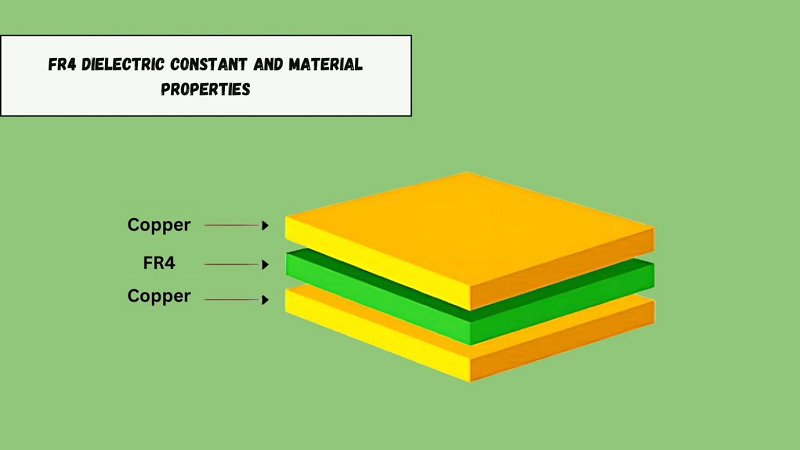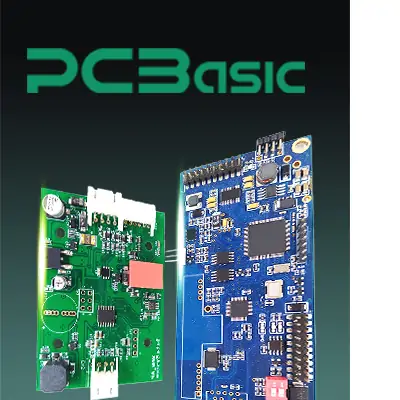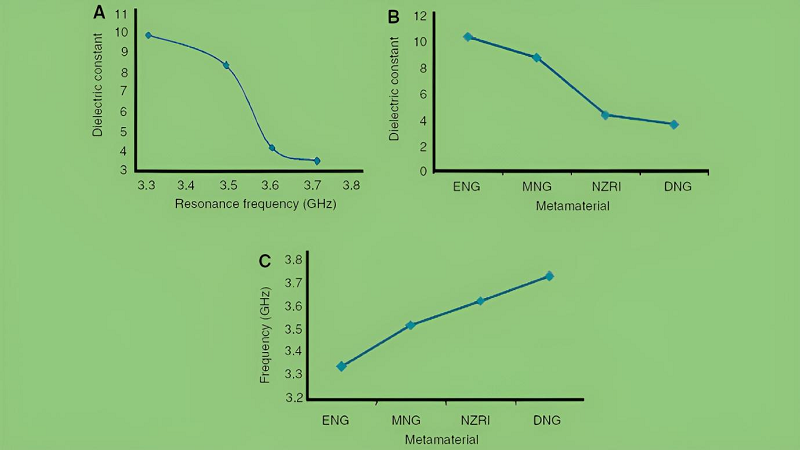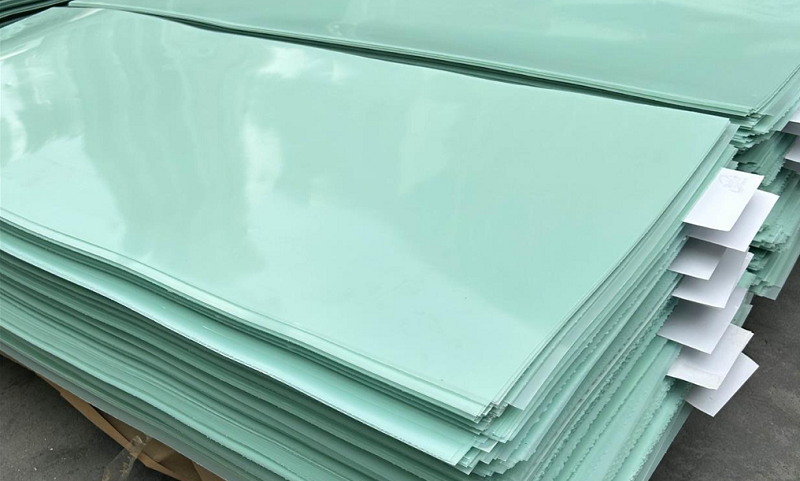Global high-mix volume high-speed PCBA manufacturer
9:00 -18:00, Mon. - Fri. (GMT+8)
9:00 -12:00, Sat. (GMT+8)
(Except Chinese public holidays)
Global high-mix volume high-speed PCBA manufacturer
9:00 -18:00, Mon. - Fri. (GMT+8)
9:00 -12:00, Sat. (GMT+8)
(Except Chinese public holidays)
HomePage > Blog > Knowledge Base > FR4 Dielectric Constant and Material Characteristics

The selection of material is the most essential part of getting good performance and reliability in manufacturing a PCB. FR4 remains the most commonly used material due to the balance it offers in electrical properties, FR4 mechanical properties, and FR4 thermal conductivity. Indeed, one of the significant characteristics of FR4 relates to the fact that Dk, or dielectric constant, heavily impacts performance in PCBs, especially at high frequency. Knowing the FR4 dielectric constant and related properties, the PCB designer will always make rational decisions toward proper signal transfer stability within the board.
The dielectric constant, the term alternatively used with relative permittivity, is the storage ability of the material when it comes to electrical energy in an electric field. It means how much electric charge a particular material can hold against a vacuum and what the dielectric constant represents. For FR4 materials in PCB applications, the dielectric constant represents how much signal is propagated across the board without interference.
The dielectric constant practically influences the following characteristics of PCB.
● Signal Transmission: Because materials of high dielectric constant make the capacitance between the conductors bigger, they decelerate signal transmission. That could be helpful to some designs, but most of the time, it leads to a problem in PCBs with high speed and high frequency, which are usually designed for smooth signal flow.
● Impedance Control: Since the dielectric constant dictates impedance control, it counts in impedance control. It removes reflection and distortion in signals. A stable Dk stabilizes the impedance between PCB layers.
● Signal Loss: Higher dielectric constants contribute more to higher signal loss. As much as possible, when increasing dielectric constants, the increased quality and the high reliability of data it could transmit will also be affected. This balance must be made, particularly regarding the design's priority regarding minimum loss over distant signals.
FR4 material has a dielectric constant of around 4.0 to 4.5, although the values may vary with the composition of the resin and the variation in manufacturing. The range is moderate for high-frequency designs. However, the demand for faster, high-frequency applications in telecommunications and data processing has led designers increasingly to choose materials with lower Dk values to ensure signal integrity.
Signal velocity and stability will be interfered with by the dielectric constant, which the PCB manufacturers/designers have to take into consideration in the preliminary phases. FR4 causes the boards to distort phases during high-frequency application due to dielectric constants in FR4, creating time differences in the paths where signals at different frequency intervals take to reach specific points, thus resulting in loss or errors in the information transmitted. FR4 is used where the frequency is low to medium or otherwise, where signal fidelity is less important.
 About PCBasic
About PCBasic
Time is money in your projects – and PCBasic gets it. PCBasic is a PCB assembly company that delivers fast, flawless results every time. Our comprehensive PCB assembly services include expert engineering support at every step, ensuring top quality in every board. As a leading PCB assembly manufacturer, we provide a one-stop solution that streamlines your supply chain. Partner with our advanced PCB prototype factory for quick turnarounds and superior results you can trust.

Another very critical characteristic of dielectric behaviour concerning frequency dependence is that material changes slightly with frequencies greater than 1 GHz. These would reflect the fact that the dielectric constant of FR4 changes at frequencies greater than 1 GHz and, therefore, reflects on the speed of signal and phase accuracy.
Such effect, although low, is much more critical in high-speed digital and RF applications wherein uniform propagation of signals is desirable. However, in FR4, dispersion exhibits a bit of dielectric constant decreases with increasing frequency.
Although such a degree of variation was acceptable for most conventional applications, there were lots of high-frequency and 5G applications that rendered it inevitable for the manufacturers to look for alternative materials other than the conventionally used FR4 material. In this way, low-loss FR4 and the modified materials had small values of DK, which allowed the achievement of far more stable performance in far more extensive ranges of frequencies.

|
Property |
Value |
|
Thickness (mm) |
1.6 |
|
Dielectric Constant (εr) |
4.7 |
|
Loss Tangent (tan δ) |
0.019 |
|
Dissipation Factor |
0.020 |
|
Surface Resistivity (MΩ) |
4 × 10^7 |
|
Volume Resistivity (MΩ·cm) |
10^8 |
|
Water Absorption (%) |
0.10 |
|
Thermal Conductivity (W/m·K) |
0.3 |
|
Thermal Expansion Coefficient (ppm/°C) |
14–17 (x-y direction), 70 (z direction) |
|
Decomposition Temperature (°C) |
300 |
|
Flexural Strength (MPa) |
415 |
|
Tensile Strength (MPa) |
340 |
|
Yield Strength (MPa) |
310 |
|
Density (g/cm³) |
1.85 |
|
Operating Temperature Range (°C) |
-50 to 140 |
|
Dielectric Strength (kV/mm) |
20 |
|
Flammability Rating |
UL 94 V-0 |
FR4 is a glass-reinforced epoxy laminate known for its balanced electrical, mechanical, and thermal properties. This provides balanced properties at the electrical, mechanical, and thermal levels. The most commonly used rigid PCB material out there is FR4. Of course, it is best due to its excellent insulation, good mechanical strength, and resistance to moisture absorption. FR4 is one of the woven layers of glass fiber impregnated with an epoxy resin binder, which brings stable dielectric constants and structural stability in the multilayer layout of a PCB. Its safe dielectric properties continue to mark FR4 as one of the best available options available in the market for all applications, ranging from low-level consumer electronics to severe industrial hardware.
With high-frequency and high-speed applications increasingly in demand, PCB designers are now calling for more variations of FR4 with performance standards and controlled manufacturing costs.
FR4 relies upon a number of internal and external parameters related to the dielectric constant. Once some known values are set, these can be used to draw inferences about how the designs change from other materials or configurations.
This depends on the type of resin used and what fillers are used. The manufacturers mix the fillers in a particular manner, so this would alter the Dk for FR4. This, in turn, will be most suitable for those applications that require either low loss or high frequency. Fillers are usually added in a way that balances the shift of Dk with the frequency. It employed a number of resins to achieve a relatively low dielectric constant and much more stable characteristic.
It depends upon frequency, so it is one of the most predominant features of high-speed and RF applications. In the analysis done in this work, the effect arising because of dispersion is also present. Hence, the dielectric constant should be minimal because it increases the frequency, but for the same reason, the type of FR4 material, which is varying, is seen and categorized along with the frequency ranges applied to that. All these effects are relatively small except for elementary digital circuits and frequencies below about 1 GHz. However, any nonzero offset results in a minimal offset even at high frequencies, which is known to provoke extreme difficulties for the signal integrity of circuitry.
The other environmental factors critical to the determination of FR4 dielectric properties are absorbed moisture and temperature.
● Temperature: FR4 does increase dielectric constant with an increase in temperature. It creates a problem in scorching environments because the signals start losing performance. It could become a problem for higher frequency boards because the components involved operate at high heat.
● Moisture Absorptions: FR4 materials absorb moisture, which could be present in the ambient environment. Moisture absorbed could improve dielectric constant value; thus, degradation in signal could occur. That's why coatings might be necessary for PCBs when used in humid places or outdoor application places.
This also helps decide the dielectric attribute of FR4 laminate. The thickness of both copper and the laminate, combined with the weave of fiberglass, contributes a certain amount toward dielectric behaviour in a PCB.
● Lamina Thickness and Copper Thickness: Variation capacitance occupies the PCB stack thickness over which a signal travels. Lamina Thickness Copper Thickness.
● Fibreglass Weave: The glass in fiberglass is intrinsically graded through the board due to its weave repeat pattern. More important, however, is a laminate design that has a high layer frequency. Some designers consider spread-glass laminates for mission-critical applications.
FR4 can withstand such low tolerances during PCB manufacturing. Here, layer thickness, percentage of resin, and filler type will yield nanoscale deviations in Dk. Only these above-mentioned parameters can be controlled by the manufacturing house; however, minor variations in that parameter affect the final performance of that part for high-frequency or accuracy applications.
This means stabilization is critical in applications involving high speeds and frequencies. Control in dielectric constants through the appropriate choice of material with the proper adjustment of the variables concerned may stabilize the signal integrity.
There are suppliers offering FR4 laminates with low and high Dk. Each of them is appropriate for some applications. The FR4 laminates with low Dk can be used in order to execute designs that have a very high frequency without severe loss or distortion in phase; the high Dk variant would really be helpful in designs wherein small form factors are involved, and so it gives closer spacing of the conductors without interfering heavily with a signal.
Proper selection of FR4 material ensures impedance control and signal integrity for high-speed applications. Low-loss FR4 material is primarily utilized to minimize dielectric loss in applications such as network infrastructure or telecommunication where heavy data transmission exists. Controlled impedance designs usually require the same Dk value to avoid reflection of the signal; thus, designers often coordinate with manufacturers to have tightly controlled dielectric material properties.
The dielectric constant along the PCB stackup is controlled so that the designers can target stable signal paths. Techniques include layering material, dielectric spacers, or even changing configurations on copper planes. It assumes the desired Dk. Multilayer boards present the case wherein designers need to think about the cumulative dielectric effects because each layer contributes to the overall Dk of the stack up. Most PCB design software accounts for such factors so that the signal may be expected to behave predictably.
|
Measurement Frequency (GHz) |
Calculated Dielectric Constant (Circuit Sim) |
Calculated Dielectric Constant (Momentum) |
|
2.76 |
4.20 |
4.22 |
|
5.54 |
4.16 |
4.16 |
|
8.36 |
4.09 |
4.10 |
|
11.21 |
4.00 |
4.03 |
|
14.04 |
3.97 |
4.00 |
|
16.73 |
3.98 |
4.06 |
Thus, PCB design at high frequencies demands the correct estimation and modeling of dielectric constants so that effective testing and performance will be achievable.
1. Time Domain Reflectometry-TDR: TDR measures the dielectric constant by observing reflections happening in the transmission lines of the PCB. The results will contain very accurate impedance values.
2. Network Analysis: The network analyzers measure the dielectric properties by applying a wide range of frequencies to the material under test. In this respect, high frequency, in particular, is sometimes used to give good insights into dielectric behaviour.
3. Resonance Circuit Techniques: Resonance circuits can also measure Dk, and the reasonable accuracy values that are obtained are abundant enough to be used for verification.
Modern PCB design software is powerful at modeling dielectric behaviour. Finite Element Analysis and 3D electromagnetic simulations now predict with a high degree of accuracy how the material FR4 will behave under conditions of a range of frequencies, temperatures, and mechanical stresses. Designers may then choose the material and configurations of layers that are stable under the conditions of operation.
High-Speed PCB Design
Low Dk is especially needed for high-performance computing and networking applications to minimize signal latency.
RF Applications
Low-loss FR408 coupled with FR4 is mainly used in RF and microwave circuits to ensure signal integrity and dielectric stability in the high-frequency stages.
Another determinant that affects the high-speed and high-frequency performance of PCB is the dielectric constant. An important parameter is controlling the dielectric properties primarily through FR4 to attain signal integrity and reliability. The present trend is toward advanced PCB technology, so the material employed must have accurate measurement and modeling to cope with the current needs of electronics.

Assembly Enquiry
Instant Quote
Phone contact

+86-755-27218592
In addition, we've prepared a Help Center. We recommend checking it before reaching out, as your question and its answer may already be clearly explained there.
Wechat Support

In addition, we've prepared a Help Center. We recommend checking it before reaching out, as your question and its answer may already be clearly explained there.
WhatsApp Support

In addition, we've prepared a Help Center. We recommend checking it before reaching out, as your question and its answer may already be clearly explained there.
